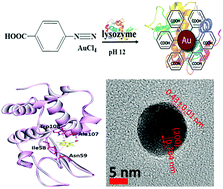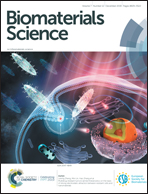Green and cytocompatible carboxyl modified gold–lysozyme nanoantibacterial for combating multidrug-resistant superbugs†
Abstract
The dissemination of multi-drug resistant (MDR) superbugs in hospital environments, communities and food animals and the very dynamic bacterial mutation frequency require the development of prolonged therapeutic strategies to gain mastery over antibiotic resistance. A AuNP–lysozyme nanoantibacterial was fabricated by the conjugation of AuNPs-C6H4-4-COOH with lysozyme via green reduction of aryldiazonium gold(III) salt [HOOC-4-C6H4N![[triple bond, length as m-dash]](https://www.rsc.org/images/entities/char_e002.gif) N]AuCl4. Results from molecular docking calculations aimed at revealing the binding mode of benzoic acid with the lysozyme structure clearly showed the lowest energy conformation with benzoic acid bound in the deep buried hydrophobic cavity of the protein active site through strong hydrogen bonding and hydrophobic interactions, thus validating the experimental outcomes of the current study which also exhibited the binding of –COOH functional groups in the interior of the protein structure. The superiority of the lysozyme bioconjugate against superbugs was demonstrated by the enhanced and broadened lysozyme antibacterial activities of 98–99% against extended spectrum beta lactamase (ESBL) producing Escherichia coli and imipenem-resistant Pseudomonas aeruginosa clinical isolates and a selection of Gram-negative and Gram-positive standard ATCC strains. Selective toxicity against bacteria was confirmed by the high viability of HeLa and fibroblast cell lines and the outstanding hemocompatibility at the minimum bacterial inhibitory concentrations (MICs). Turbidimetric enzyme kinetic assay showed the enhancement of the lysozyme hydrolytic activity by gold nanoparticles on the Micrococcus lysodeikticus bacterial substrate. Using gel electrophoresis, the induced cell wall breakdown was confirmed by detecting the leaked-out bacterial genomic DNA. The integrity and morphology changes of the E. coli bacteria were investigated using a scanning electron microscope after one hour of contact with the lysozyme–gold bioconjugate. The antibacterial functionalities showed little or no damage to healthy human cells and can be applied to wound dressings and medical devices.
N]AuCl4. Results from molecular docking calculations aimed at revealing the binding mode of benzoic acid with the lysozyme structure clearly showed the lowest energy conformation with benzoic acid bound in the deep buried hydrophobic cavity of the protein active site through strong hydrogen bonding and hydrophobic interactions, thus validating the experimental outcomes of the current study which also exhibited the binding of –COOH functional groups in the interior of the protein structure. The superiority of the lysozyme bioconjugate against superbugs was demonstrated by the enhanced and broadened lysozyme antibacterial activities of 98–99% against extended spectrum beta lactamase (ESBL) producing Escherichia coli and imipenem-resistant Pseudomonas aeruginosa clinical isolates and a selection of Gram-negative and Gram-positive standard ATCC strains. Selective toxicity against bacteria was confirmed by the high viability of HeLa and fibroblast cell lines and the outstanding hemocompatibility at the minimum bacterial inhibitory concentrations (MICs). Turbidimetric enzyme kinetic assay showed the enhancement of the lysozyme hydrolytic activity by gold nanoparticles on the Micrococcus lysodeikticus bacterial substrate. Using gel electrophoresis, the induced cell wall breakdown was confirmed by detecting the leaked-out bacterial genomic DNA. The integrity and morphology changes of the E. coli bacteria were investigated using a scanning electron microscope after one hour of contact with the lysozyme–gold bioconjugate. The antibacterial functionalities showed little or no damage to healthy human cells and can be applied to wound dressings and medical devices.



 Please wait while we load your content...
Please wait while we load your content...